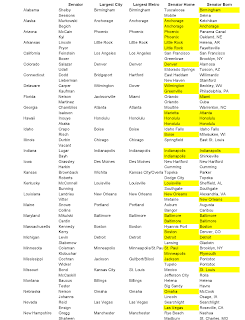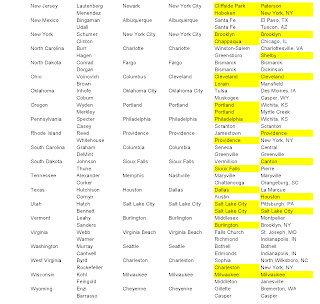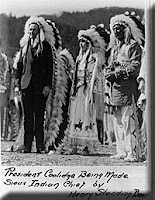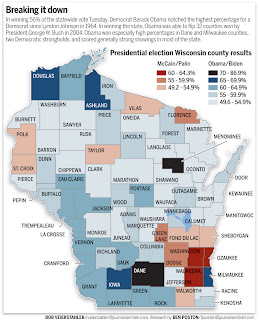
Last week I came across
this article about Obama’s win in North Carolina. Mentioned at the end is the claim that Obama’s win can be partially explained by increased turnout not just among African American voters, but especially students at
Historically Black Colleges and Universities (HBCU's). The Tarheel State has 11 HBCUs. This got me thinking about the role of this student group across the country and whether or not we can point to any clear gains made by the Obama camp as a result of this energized student base. Also bolstering my interest in this question was the fact that last weekend saw the playing of the annual
Bayou Classic in New Orleans, one of my favorite sporting events of the year to watch. If you don’t think the Obama win was important to the student bodies of
Southern and
Grambling State Universities, check out the halftime performance of the “Battle of the Bands”—in many ways a more passionate and heated contest than the football game itself (Southern
here, Grambling State
here).
Thus, I decided to build a database of voting across the HBCU universe and do some number crunching. The database has been
posted here (Google account required) along with the
explanatory key for each column.
HBCU’s were created, beginning in the aftermath of the Civil War, to allow African Americans access to higher education. The vast majority of these schools are located in states of the Deep South, which isn’t surprising given the degree to which blacks were excluded from college enrollment in these states’ flagship universities. Thus, HBCU’s have for decades acted as the route to the professions for many of the country’s black students. Currently, about 14% of all African Americans in college attend an HBCU and about 25% of the bachelor’s degrees awarded to African Americans come from one of these schools. Over time, several HBCU’s have not only welcomed non-black students but have become predominantly white or other minority. The
University of Texas El Paso, for example, is now over 70% Hispanic. This school, formerly known as Texas Western, has an important place in collegiate athletics and HBCU history in that its 1966 national championship men’s basketball team was the first to start 5 black players (against the all white University of Kentucky dynasty). Thus, their role not only in educating the black community, but the nation as a whole, has been vital.
There are currently 103 HBCU’s across the country, located in 22 states and 76 counties. Only a small handful are outside of what we would consider “the South”—Lewis College of Business in Detroit; Cheyney and Lincoln Universities in Pennsylvania; Charles Drew University of Medicine and Science in Los Angeles are examples. Alabama is the state with the most HBCU’s—14. Next among the states with many such schools are North Carolina (11), Georgia and Texas (9), and Mississippi and South Carolina (8). Another thing one notices, and which is included in the database, is the diversity in the size of each of these schools. Some have only a few hundred students while others are quite large—Howard University, Florida A&M, Texas Southern, and Southern University are among the largest. Overall, however, in looking at enrollment size, it doesn’t seem as if these schools—within their respective counties—provide enough votes to truly sway an election.
When we look at how each of these schools’ counties voted this year—and compare this year’s race to 2004’s--what do we see? First, Barack Obama won 52 of the 76 counties in which HBCU’s are located. While on the surface this might have been useful for Obama in capturing several states, the reality is that many of these wins took place in states that went solidly for McCain. For example, as mentioned Alabama contains 14 HBCU’s yet was won by McCain with 60%. At the county level, Obama won 3 of the 8 counties containing these schools. Likewise, in Mississippi, Obama won all 6 of the counties containing its HBCU’s and in South Carolina he won 4 of 5 HBCU counties (McCain won each state with 56% and 54% respectively). This fact, it seems, illustrates a much larger point not only about the history of the HBCU movement but about America’s complicated political history.
In numerous posts over the past year or so I’ve dwelled upon the debate about white vs. black voting in the Deep South. What we’ve seen, through not only exit polling, but also simple geography and demographics, is that there has been a clear divide between black and white voters in the region. For example, most of these HBCU’s are physically located in counties that have very sizable black populations. 58 of the 103 HBCU’s reside in counties that are at least 30% African-American. Thus, it would seem as if the decision about where to locate these schools was very deliberate. Because these schools in many cases served a population that was underserved and lacking in resources it made sense to have them close to where the student body would hail from. Also, one wonders how successful these schools would have been (or even if they could have been created) had they been located in overwhelmingly white areas. For example, only one HBCU (
Clinton Junior College in Rock Hill, SC) is located in a county that is less than 20% black in the Deep South states of South Carolina, Georgia, Alabama, Mississippi, or Louisiana. Worth remembering is the degree to which the residence of the black population in the South (as seen across counties) has been remarkably stable. Thus, returning to the vote this year, it seems as if the Obama vote we see at the county level is not so much a result of these schools bringing political change to an area, but rather amplifying the underlying preferences that have always been there. Obama’s candidacy energized this underlying Democratic allegiance and gave it reason to turn out in greater force than it had in years past.


When we compare this year’s vote to 2004, while we do see evidence of change, some of it seems due to other factors. Whereas Obama won 52 of the 76 HBCU counties, John Kerry managed to win only 39. Obama’s improvement on Kerry’s number took place across 8 states, flipping three counties in North Carolina (Cumberland, Forsyth, and Wake); 2 in Louisiana (East Baton Rouge and Caddo) and Texas (Dallas and Harris); and one each in Alabama (Jefferson), Delaware (Kent), Florida (Leon), Georgia (Peach), Pennsylvania (Chester), and Virginia (Henrico). The Texas wins in the counties containing Dallas and Houston can be attributed to no longer having native Texan George Bush on the ballot. Likewise, the addition of Delaware’s Kent County can be tied to Joe Biden’s VP nomination. Here is a breakdown of these counties, their Obama vote %, Black % vote, and HBCU enrollment:
Jefferson AL (Birmingham) 52.6% Obama, 39.4% Black, 3000 Students
Kent DE (Dover) 55.0% Obama, 20.7% Black, 3000 Students
Leon FL (Tallahassee) 62.2% Obama, 29.1% Black, 10000 Students
Peach GA (Ft. Valley) 53.4% Obama, 45.4% Black, 2500 Students
Caddo LA (Shreveport) 51.5% Obama, 44.6% Black, 1100 Students
E. Baton Rouge LA (Baton Rouge) 51.1% Obama, 40.1% Black, 11000 Students
Cumberland NC (Fayetteville) 58.9% Obama, 36.7% Black, 4000 Students
Forsyth NC (Winston-Salem) 55.3% Obama, 25.9% Black, 2800 Students
Wake NC (Raleigh) 57.3% Obama, 19.7% Black, 4300 Students
Chester PA (Cheyney) 54.6% Obama, 6.2% Black, 2800 Students
Dallas TX (Dallas) 57.7% Obama, 20.3% Black, 700 Students
Harris TX (Houston) 50.8% Obama, 18.5% Black, 10000 Students
Henrico VA (Richmond) 56.2% Obama, 24.7% Black, 1500 StudentsOf those remaining counties, the only county with both a close margin of victory for Obama and a sizable HBCU population is East Baton Rouge Parish in Louisiana. Thus, whereas Southern University may have lost the Bayou Classic on Saturday, their vote may have helped tipped their county to Obama’s side, something Grambling State wasn’t able to do in Lincoln Parish which went heavily for McCain. Whereas Leon County Florida has a big HBCU population (
Florida A&M) it was quite lopsided in its support for Obama. The presence of Florida State University there and its big student population might explain some of the margin and could perhaps show a greater tendency of white and black students to vote in a more colorblind way. For the North Carolina county flips, we see both relatively large margins for Obama and a relatively small HBCU population.
What are some other things we see when crunching these numbers??? Overall, Obama’s performance across these counties greatly improved on that of Kerry, something McCain was not able to replicate vis a vis George Bush. Compared to 2004, the Democrats got a higher % of the vote in 72 of the 76 counties considered here. Obama only underperformed Kerry in Jefferson County Arkansas (which he still won handily), Mercer County West Virginia, and Harrison and Wood County Texas. While McCain’s county %’s versus 2004 are dismal (only gaining in the 4 Obama declined in), an even worse scenario emerges when we look at raw vote totals. Given that the size of the electorate increases over time and that this year saw higher turnout than 2004, one would assume that both McCain and Obama would get more votes in each county than Bush and Kerry did respectively. Not so. Whereas Obama got more votes than Kerry in 70 of 76 counties, McCain only got more votes than Bush in 31 of the 76!!!! And remember, we’re mostly talking about the Deep South here. When you compare the improvements that Obama made with these declines suffered by McCain, you see how Obama was able to turn some areas from red to blue. Here, North Carolina jumps out.

Obama won North Carolina by 14,177 votes. In the HBCU database, we saw how Obama flipped Cumberland, Forsyth, and Wake County. Looking at the net vote gains (Democratic gains in 2008 over 2004 minus Republican gains in 2008 over 2004) in these three counties, Obama had a net increase of 126,563 votes. That’s your win right there. If you take other strong Obama counties in the state included here—Mecklenburg (Charlotte),
Guilford (Greensboro), and Durham (Durham)—you add an additional 162,154 votes!!! That’s nearly 290,000 votes gained in just 6 counties. Not only did Obama vastly overperform in North Carolina, McCain didn't even break even with past Republican showings. That is a sure fire way to lose.
Another state that I thought might show a similar dynamic was Virginia. Overall Obama had a 234,527 vote cushion. In the database here, there are 3 counties with an HBCU (Brunswick, Henrico, and Prince George) plus Hampton and Norfolk cities which are not part of a county jurisdiction. When you add up the net gains made by the Democrats one sees that Obama had a 70,928 vote advantage. Thus, while the Democrats increased their performance against the Republicans vis a vis 2004 in these counties, they had to rely on other counties, especially in northern Virginia to put them over the top. I should be clear that in neither North Carolina nor Virginia do I suggest that the HBCU presence and student vote were the reason these states switched from red to blue. I’d make the same caveat about the county level results as well. Rather, using this lens through which to view the election returns allows us to pick up on things we may otherwise have missed.
By focusing on HBCU’s, the data shows that we are for the most part looking at counties that are southern, black, and consistently Democratic. The Obama campaign and the 2008 election seem to have energized this electorate and given them the opportunity to elect the country’s first black president. Given the politics of the states in which most of these schools exist, we didn’t see the Obama campaign rack up massive numbers of electoral votes. States like Alabama, Mississippi, Louisiana, and South Carolina were never really in serious danger. Most of the gains made by the Democrats in these states and elsewhere seem attributable just as much to Republicans staying home as new Democrats turning out. In those states that did switch (North Carolina and Virginia) other factors surely contributed to the gains—greater white support for Obama, the economic crisis, etc. The HBCU’s, in short, didn’t make Barack Obama our next president. Nevertheless, beyond the more academic exercise of crunching election returns by using HBCU’s as a prime variable, one can’t deny the meaning that this election had to these schools’ students. If you don’t believe that, watch
this.





 To get a sense of why they're still counting votes in the Minnesota Senate race, the above maps might be instructive. Obviously, Obama's support was more widespread than Al Franken's. Initially, I thought the reason Franken wasn't able to capitalize on Obama's big win was due to underperformance in Ramsey County (St. Paul). Being Norm Coleman's home--he was Mayor of St. Paul prior to running for the Senate--this wouldn't be surprising.
To get a sense of why they're still counting votes in the Minnesota Senate race, the above maps might be instructive. Obviously, Obama's support was more widespread than Al Franken's. Initially, I thought the reason Franken wasn't able to capitalize on Obama's big win was due to underperformance in Ramsey County (St. Paul). Being Norm Coleman's home--he was Mayor of St. Paul prior to running for the Senate--this wouldn't be surprising.
.jpg)
 Last week I came across
Last week I came across 

























